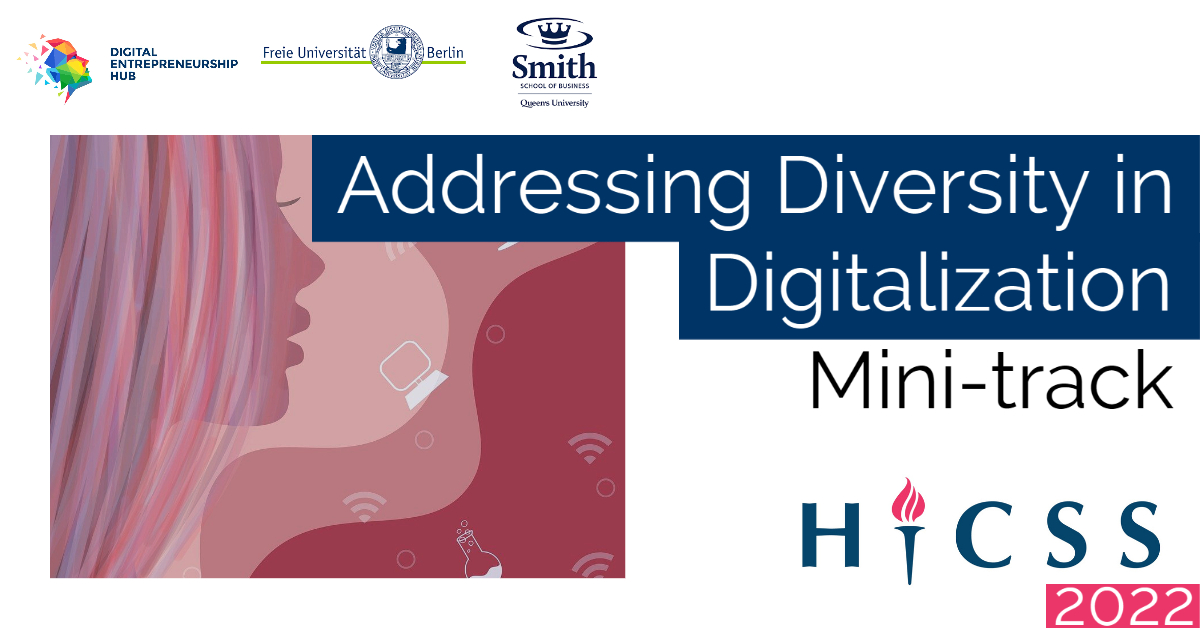
on 5. March 2021 by Hannes Rothe com Comments Off on Minitrack on “Addressing Diversity in Digitalization” at HICSS 2022 cat News
Addressing Diversity in Digitalization (Minitrack at HICSS 2022)
In this mini track, professors Sundermeier, Rothe (both DEH) and Chan (Queens University) invite scholars to advance our theoretical knowledge on the digital impact on diversity, i.e. on inclusive design and application processes, practices and routines of organizing data and information systems that consider the role of diversity, and the influence of diversity in shaping the role, usage, and design of digital technologies. We are open towards diverse methodological and theoretical approaches and welcome contributions from scientists and practitioners likewise.
Please visit the conference website for more detailed information.
The term diversity has raised much attention from scholars and practitioners alike to discuss how different viewpoints, mindsets, educational backgrounds, perspectives, and knowledge (or the lack thereof) contribute to the ongoing digitalization in a variety of industries (Olbrich et al., 2015; Sundermeier et al., 2020; E. M. Trauth, 2017). Despite the presence of the topic in scholarly publications and public discourses, numerous examples indicate how homogeneity, instead of diversity in the previously outlined dimensions, leads to the development of digital technologies that can be used to discriminate against certain groups (Schmitt et al., 2020; E. Trauth et al., 2018; Urquhart & Underhill-Sem, 2009).
We only have a limited understanding of the relationship between digitalization – the “phenomena and processes of adopting and using [digital] technologies in broader individual, organizational, and societal contexts” (Legner et al., 2017) – and diversity, which can be understood as the “the distribution of differences among the members of a unit” (Harrison & Klein, 2007, p. 1200) with respect to demographic (e.g. age, gender, nationality, ethnicity), functional (e.g. education, work experience, religion, income) and deep-level (e.g. diseases, disabilities, traits, values, beliefs) attributes.
At least two explanations are available for relationship between digital technologies and diversity (Sundermeier et al., 2021). Either these newly created technological structures reveal a lack of diversity in the underlying social structures, or they help to create them. We have learned how machine learning algorithms in recruiting discriminated against female applicants (Paul, 2019) or facial recognition software fostered racial discrimination (Schmitt et al., 2020; E. M. Trauth, 2017). Digital technologies start with representing our physical world with bits and bytes (Yoo et al., 2012) and oftentimes, we find, they apply homogeneous categories in the process. In the given examples, we first see that digital technologies are trained on data reflecting male dominance in tech industries or existing recruiting patterns that support homogeneous workforces. Second, these technologies recreate and reinforce already dominant categories and homogeneous structures.
It is therefore worth asking whether digitalization can thereby be considered a ‘diversity-blind’ process. In order to promote greater awareness of diversity in this respect, it is important to encourage the generation of theoretical knowledge that can help to explain how digital technologies influence diversity (digital impact on diversity) and how digital technologies are shaped by diversity or the lack thereof (diversity shaping digital technology). Eventually, this understanding might help academics and practitioners alike in their efforts towards inclusive design and application processes that avoid the pitfalls described earlier.
In this mini track, we invite scholars to advance our theoretical knowledge on the digital impact on diversity, i.e. on inclusive design and application processes, practices and routines of organizing data and information systems that consider the role of diversity, and the influence of diversity in shaping the role, usage, and design of digital technologies. We are open towards diverse methodological and theoretical approaches and welcome contributions from scientists and practitioners likewise.
Contributions to this mini track may include, but are not limited to:
- ‘DIGITAL IMPACT ON DIVERSITY’ PERSPECTIVE
- Understanding practices that address diversity issues in designing digital artifacts
- Theorizing challenges related to the consideration of different dimensions of diversity in designing digital artifacts
- Understanding implications of considering and neglecting societal diversity in designing digital artifacts
- ‘DIVERSITY SHAPING DIGITAL TECHNOLOGY’ PERSPECTIVES
-
- The role of individual identity and diversity in routines and practices associated with the design and application of information systems and data
- The role of individual identity and diversity in organizational capabilities related to digitalization
- Understanding outcomes of (less) inclusive design processes and organizing practices (e.g. for marginalized or disadvantaged groups)
- Highlighting the consequences of missing diversity reflections in design processes for digital artifacts across levels of analysis (e.g. designer, venture, society)
- Development of theoretical frameworks that allow to holistically capture impacts of (less) inclusive design practices for digital artifacts
This post is also available in: German



Recent Comments